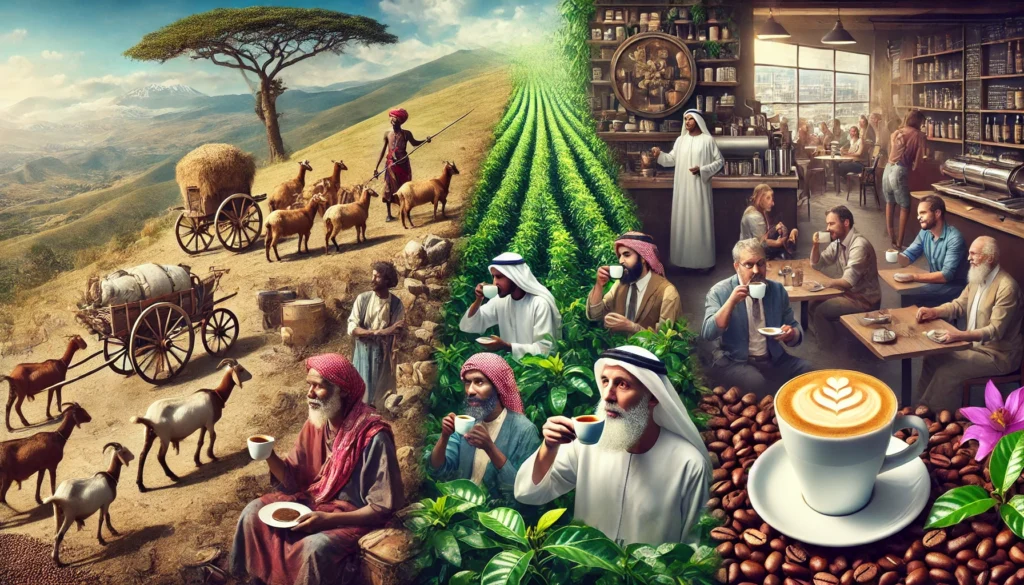Few beverages have influenced global culture and economy as deeply as coffee. From humble beginnings in the Ethiopian highlands to becoming the morning ritual of millions, the journey of coffee is rich, complex, and full of intrigue. In this article, we’ll explore the origins of coffee, how it spread across continents, and how it evolved into the global phenomenon we know today.
The Legend of Kaldi: Coffee’s Mythical Origin
According to popular legend, coffee was discovered by a goat herder named Kaldi in Ethiopia, around the 9th century. Kaldi noticed that his goats became unusually energetic after eating the red berries from a certain shrub. Curious, he tried them himself and felt a surge of vitality.
He brought the berries to a local monastery, where the monks disapproved of their stimulating effects and threw them into the fire. The roasting beans released a pleasant aroma, which led the monks to experiment by brewing a drink—thus, the first cup of coffee was born.
Though this tale is more myth than fact, it sets the stage for coffee’s origin in Ethiopia.
Coffee’s Spread Through the Arab World
Coffee cultivation and trade began on the Arabian Peninsula. By the 15th century, it was being grown in the Yemeni district of Arabia and consumed in Sufi monasteries, where it was used to aid concentration during night prayers.
From Yemen, coffee spread to Egypt, Persia, and Turkey. By the 16th century, it had become deeply embedded in the culture of the Middle East. Public coffee houses known as qahveh khaneh began to appear in cities like Mecca, Cairo, and Constantinople. These venues became hubs for intellectual discussion, music, and games—much like cafés today.
Coffee was such a central part of Islamic culture that it was sometimes referred to as the “wine of Islam,” offering a socially acceptable alternative to alcohol.
The European Encounter with Coffee
Coffee reached Europe in the 17th century through Venetian trade routes. Initially met with suspicion, it was dubbed the “bitter invention of Satan.” However, after being approved by Pope Clement VIII, who enjoyed its taste, coffee quickly gained popularity across the continent.
Coffeehouses sprang up in major cities such as London, Paris, and Vienna. In England, they were nicknamed “penny universities” because, for the price of a penny, one could purchase a cup and engage in stimulating conversation.
These early European coffeehouses played a significant role in the Enlightenment, serving as meeting places for writers, scientists, and philosophers.
Coffee and Colonialism
As demand for coffee grew in Europe, colonial powers began cultivating it in their overseas territories. The Dutch introduced coffee to Java in the 17th century, and it became a major export of Indonesia. The French brought coffee to the Caribbean, and the Portuguese to Brazil.
The rise of coffee cultivation was closely tied to the exploitation of enslaved labor. Plantations were established across the tropics, turning coffee into a global commodity but also leaving behind a painful legacy of human suffering.
Brazil’s Role in Coffee History
Today, Brazil is the largest producer of coffee in the world—a status it has maintained since the 1840s. Coffee transformed the Brazilian economy and landscape, particularly in states like Minas Gerais and São Paulo.
The growth of coffee plantations fueled urbanization and industrial development, but also intensified social inequality. Over the centuries, Brazil became synonymous with high-quality Arabica beans and continues to be a leader in innovation and sustainability within the coffee industry.
The Evolution of Coffee Culture
Coffee culture evolved differently around the world. In Italy, espresso became a national staple. In Sweden and Finland, fika (coffee breaks with pastries) is a beloved daily ritual. In the U.S., the rise of diners and later specialty coffee chains like Starbucks reshaped how people consume coffee—on the go, customized, and socially.
More recently, the third wave of coffee has emphasized transparency, sustainability, and craftsmanship. This movement treats coffee like wine: with careful attention to its origin, processing, roasting, and brewing.
A Global Symbol of Connection
Coffee has become more than a beverage. It’s a symbol of community, creativity, and comfort. Whether shared in a small café in Paris or brewed in a cozy kitchen in São Paulo, coffee connects people across cultures and continents.
Its journey from Ethiopian legend to your morning mug is a testament to how a simple bean can shape economies, traditions, and human connection.
Why the History of Coffee Still Matters
Understanding the history of coffee is key to appreciating its value—not just in economic terms, but as a force that has shaped societies. Today, coffee continues to evolve, influenced by technology, climate change, and cultural shifts. Yet its essence remains unchanged: a drink that brings people together and inspires the world.
